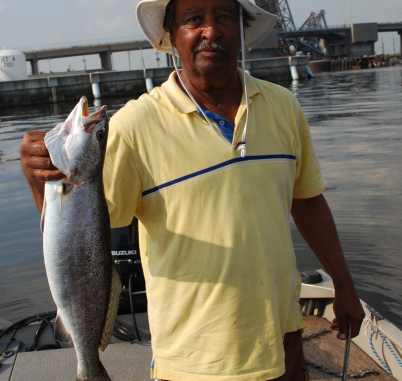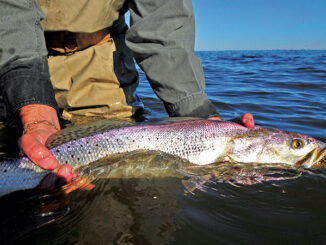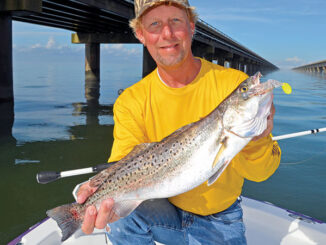
Sumas consistently catches big fish
Fishing out of Seabrook, the mouth of the Inner Harbor Canal to Lake Ponchartrain, Allen “Chink” Sumas Jr. once caught nine speckled trout that weighed-in at 9 to 9 ½ pounds – in a single day.
He’s known for catching big trout, and in this excerpt from Trout Masters: How Louisiana Anglers Catch the Lunkers, Sumas talks about prime fishing locations and how he tackles Seabrook.
Today, Sumas is a fixture at Seabrook, where he now does all of his fishing. He lives on St. Roch Avenue in New Orleans, five minutes from the boat launch at Seabrook, and is fishing one minute after launching. He half-jokingly calls two minutes “a long boat ride.”
Sumas usually launches his boat well before daylight to give him time to trawl up a supply of shrimp or croakers directly out from the launch and fishing area.
On a recent trip, he had the luxury of not having to trawl before daylight, as a friend had shared some of his live bait with him, although he would have to use his 22-foot trawl later in the morning to replenish his livewell.
With daylight’s visibility approaching, Sumas triangulated his boat into exactly the right position by lining up buildings, trees and lights on the shore. While the area known as Seabrook is small, the best fishing spots are even smaller, as in room-sized. He stated confidently that only six or seven such prime spots exist at Seabrook, and that one has to be able to drop his anchor in a “55-gallon barrel-sized spot” to fish them.
He quietly explained while lining the boat up with his landmarks that on an average day, more than 50 boats will fish Seabrook, but only five will know how to consistently find and catch specks.
“The rest are ‘do gris,’ catching white trout, if anything,” he said.
He allowed that sometimes most of the boats catch fish because the specks are everywhere, and occasionally an inexperienced fisherman can and will anchor in the right spot by accident.
Sure enough, by 5:30 a.m. there were 15 boats anchored around us. By 6 a.m., the count was 28 boats, and by 6:15 a.m., it reached 37 boats. The closest boats were less than 25 feet away. Every boat was within a half mile of the launch.
Sumas was nonplussed by the crowd, saying weekends see 60 to 70 boats. Only at Seabrook will you see boats fishing this close to each other for speckled trout and catching them. Some of the regulars, such as Sumas’ friends Dudley Vandenborre, Bruce Boe, Doc (Bob) Weiss, Ms. (Carmelo) Thibodaux and Stanley Roby, will anchor almost end to end or even tie up to each other when one boat is really on the fish.
The Seabrook regulars form a fraternity, complete with their own coded signals. A subtle flick of a hand, tip of a hat or wave of a rod or bait dip net provides visual communication between them. They routinely stop and talk to each other to share bait or information about the bite.
That day, fishing started slow, with his first fish, a 10-inch white trout, causing Sumas to mutter his embarrassment. But it gradually picked up in size of fish and tempo, although the pace could never be considered blistering hot.
Sumas alternated between using shrimp and croakers as bait on a treble hook-rigged Carolina rig and later a slip cork. Sumas explained that he fishes one of four ways.
First is using live bait with a sliding cork, typically set for 13 feet deep, although he will vary the setting at times. Sumas, who describes himself as “the slip-cork king,” makes his own cork stoppers by cutting small squares from plastic storage containers and perforating them with a hot needle.
He never ties the knot that the slip cork stopper rides against directly in the fishing line, but rather knots a short piece of monofilament onto the line. He uses an 18-inch, 30-pound test shock leader between the line and the hook and a 1/2- to 1-ounce of weight, depending on the tide. Slip corks are best used when fish are suspended.
Sumas’ second method of fishing is using live bait with a Carolina rig using 3/8- to 1-ounce barrel sinkers, depending on the strength of tidal currents. Sumas pre-makes his Carolina rigs with 24 inches of 30-pound-test mono, and stores them in plastic bags to save rigging time when the fish are biting. Carolina rigs are used when tides are strong and the fish are on the bottom.
His third method of fishing is freelining live bait. No cork or weight is used. Eighteen to 24 inches of monofilament shock leader is attached to the main line with a small swivel. The only time this system works at Seabrook is on a weak tide, he explained, when nothing else seems to work.
Finally, Sumas uses artificials, almost exclusively Deadly Dudley soft plastics, usually from mid-March through April and in November-December. His preferences are the Straight Tail in blue moon color and the Terror Tail in blue moon with a chartreuse tail.
He has fished everything from tandem-rigged, plastic red worms through Mighty Mites, Bingos, shad rigs, MirrOlures and every sort of spoon, and he is adamant that Deadly Dudleys work best.
“They make a thousand lures that fishermen like and only five that fish like,” he said. “I’m a Dudley freak right now.”
Chink Sumas’ tips
1) Fish enough to develop confidence in yourself. Fish a lot. Ted Williams said, “The more I practice, the better I get.”
2) Learn how to find fish. Think and fish in terms of finding fish patterns, not catching fish.
3) Learn how to set up on fish to get the right angle. Fish in a spot won’t bite presentations from just any angle. You learn this by trial and error and watching other people.
4) Give fish what they want to eat. For example, never fish at Seabrook with cocaho minnows. The fish there prefer, in descending order: croakers, big shrimp, shiners (pogies) and last, mullet.
5) Find your own fish. Don’t try to catch fish someone else has located. Usually you won’t have the right angle.
6) If possible, fish a new area with someone who knows it. Try to learn from the best.
7) Pay attention to every little thing in your surroundings every time out, and store what you learned in your memory.
8) Fish fast when the fish are biting. Fishing for big trout involves a lot of lulls between action. Have new tackle ready to quickly tie on if you break off.
9) Don’t give up too quickly.
Learn more about how the best guides and anglers across the Louisiana coast catch trout day in, day out by purchasing the Trout Masters Tool Kit, which includes a special package price for Trout Masters: How Louisiana’s Best Anglers Catch the Lunkers and Trout Masters Too: How the Pros do it.


